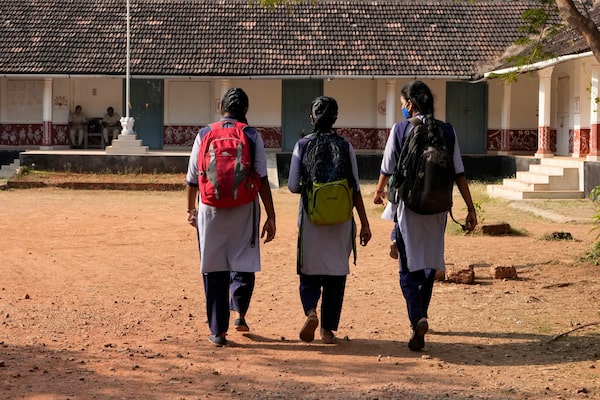
Indian students in uniform clothing arrive at a government-run junior school in Udupi, Karnataka state, India, on Feb. 24.Aijaz Rahi/The Associated Press
John Richards is a professor at Simon Fraser University’s public policy school. Shahidul Islam is a PhD student at Queen’s University. They, along with Manzoor Ahmed, are the co-authors of The Political Economy of Education in South Asia.
“Schooling without learning is a terrible waste of precious resources and of human potential.”
The quote comes from Jim Yong Kim’s foreword to a major 2018 report on primary and secondary education in developing countries. At the time, he was president of the World Bank.
What prompted the quote was the failure to realize the 2015 education targets in the United Nations Millennium Development Goals. He was also concerned about the more ambitious 2030 targets in the sequel, the Social Development Goals.
During the Millennium Development Goals’ lifespan of 2000 to 2015, many countries dramatically increased student enrolment and completion of the primary cycle. By 2015, about 95 per cent of school-age children in South Asia were enrolled in school, and in India, Bangladesh and Nepal, about 80 per cent of the primary-age cohort completed primary school. So far, so good.
But obstacles – ranging from inadequate school budgets to civil wars and corrupt administration – are preventing children from learning in government schools. And while a developing country can make modest economic progress without a decent public school system, the great majority of adults need to be able to read and do basic arithmetic before a country can achieve what the World Bank designates as “upper middle income” status.
What is the evidence of students in school but failing to learn? There are two direct sources and one indirect.
The first direct source is The World Bank’s “learning poverty” index results, which were released in 2021. It estimates the share of children aged 10 to 14 who cannot read at a basic level. The index comprises two groups: children who had dropped out of school or never enrolled, plus children in school at Grade 5 but who are unable to read at a basic level.
In India, for example, about one in five children aged 10 to 14 are out of school, and among those who are in school, nearly half are unable to read at a basic level. Overall, 55 per cent of this age demographic (children ages 10 to 14) are estimated to be “learning poor.” In Bangladesh, 58 per cent fall under this category; in Pakistan, the number is 75 per cent. In contrast, only 15 per cent of Sri Lankan children aged 10 to 14 are learning poor. (Sri Lanka is the only country to have achieved the World Bank’s upper middle income status.)
The learning poverty situation in Sub-Saharan Africa is more severe than in South Asia. Among the eight countries reporting, the learning-poor rate ranges from Cameroon (77 per cent) to Niger and Chad, which both have rates of 98 per cent.
The second source is large-scale ASER surveys of learning outcomes in rural India, organized by the Indian NGO Pratham. For more than a decade, Pratham has conducted biannual surveys with samples of about 400,000 children. (Since 2016, it has conducted similar surveys in rural Pakistan.) The benchmarks are easy to understand – literacy is assessed according to the ability to read fluently a short story from the Grade 2 curriculum in the regional language; numeracy is assessed by doing two-digit subtraction and dividing a three-digit by a one-digit number. From the 2008 ASER survey to the 2018 one – the latest pre-COVID – Grade 5 results declined. In 2018, half the students sampled at Grade 5 could read the story; slightly over a quarter met the numeracy benchmark.
The indirect evidence comes from the flight of families with some discretionary income from government schools to “low-fee” private schools. The ASER surveys revealed a growth in the non-government school share to about one-quarter of all primary students. In general, these private schools achieve better results than government schools, but they are not a solution for the poorest.
In a recent article, three senior education academics discussed “fatigue” among donor countries that have undertaken major education funding over the last several decades. (Between 2012 and 2019, Canada spent over $1.5-billion on education aid.) One obvious explanation is a lack of credible evidence of learning.
Developing countries are not colonies; their governments must decide for themselves the priority placed on realizing effective public schools. However, the role of donors is not to top up host governments’ school budgets, no questions asked.
Global Affairs Canada, for instance, has placed a high priority over the last decade on girls’ access to schooling. A modest extension to insistence on gender equity would be a requirement for transparent, independently administered learning assessments for education projects partially funded by Canadian aid.
After all, if you don’t know where you are, you are unlikely to get where you want to go.
Keep your Opinions sharp and informed. Get the Opinion newsletter. Sign up today.